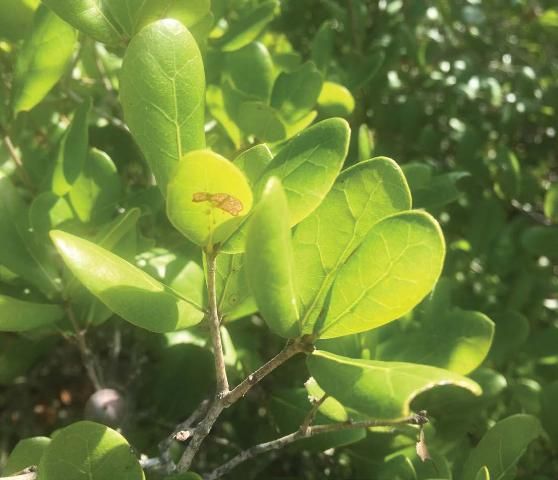Note: This fact sheet is also available as a chapter in a comprehensive manual titled Dune Restoration and Enhancement for the Florida Panhandle, available in pdf form here: https://edis.ifas.ufl.edu/publication/SG156. Please see the manual for more information about other useful and attractive native plants for dunes and for further information about restoration and preservation techniques.
Fagaceae

Credit: Ashlynn Smith, UF/IFAS
Myrtle oak is one of the three scrub oaks characteristic of scrub communities. It occurs on coastal regions of the Florida Panhandle and throughout the Florida peninsula and coastal southeastern United States west to Mississippi and east to South Carolina. The acorns of myrtle oak are an important food source for wildlife.
General Description
Myrtle oak is within the red oak group and may be present as a shrub or tree. The red oak group (synonym sect. Erythrobalanus) produces acorns that mature in 18 months (generally on the previous season's growth at maturity) and are frequently described as very bitter. Myrtle oak is an evergreen shrub to small tree that can reach heights of 40 ft. Leaves are simple, alternate 0.8 to 3 in long by 0.4 to 2 in wide, variably shaped (elliptic, oblong, or oval), with margins entire to lobed and revolute, dark green upper surfaces and dull to yellowish green lower surfaces. When mature, leaves lack pubescence. Inflorescences are catkins that appear in spring. Fruits are globose acorns; the insides of the acorn shells are woolly.
Propagation
The authors have successfully germinated this plant in tree tubes within a climate-controlled greenhouse. After a late fall collection of acorns, plants were grown in a medium of 3 parts pine bark to 1 part horticulture media growing mix. Only collect acorns in late fall while still attached to the plant and without holes to avoid collecting seeds with weevil larvae inside. Perform a float test, discarding any acorns that float in water, to eliminate acorns with underdeveloped seed and many impacted by weevils.
No cutting propagation procedures for this species have been published. Additionally, cutting propagation is not considered a practical approach for oak restoration because it would limit genetic diversity. Other species of oak have been propagated from stem cuttings with various success and requirements (Griffin and Bassuk 1996).
Outplanting
Protect seeds planted in the wild from herbivores and high salinities, and bury them in the soil at a depth approximately the diameter of the acorn (Lumban Tobing 2009). The authors suggest outplanting in depressions to mimic natural dune-building processes that occur with sand accretion and to reduce initial drought stress.
Literature Cited
Griffin, J., and N. Bassuk. 1996. Preliminary progress on the asexual propagation of oaks. Combined Proceedings, International Plant Propagators' Society 46:487-494.
Lumban Tobing, S.T. 2009. "Germination and establishment of woody species with barrier island interdunal swales." Master's thesis. University of Florida.